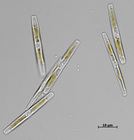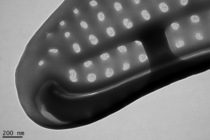
| Home | | Literature | | Log in |
| Diatoms | | Haptophytes | | Dinoflagellates | | Raphidophyceans | | Dictyochophyceans | | Pelagophyceans | | Cyanobacteria | | Greylist | | Harmful non-toxic |
HABs taxon detailsNitzschia bizertensis B.Smida, N.Lundholm, A.S.Hlaili & H.H.Mabrouk, 2014
759283 (urn:lsid:marinespecies.org:taxname:759283)
accepted
Species
marine
Smida, B.; Lundholm, N.; Kooistra, W.H.C.F.; Sahraoui, I.; Ruggiero, M.V.; Kotaki, Y.; Ellegaard, M.; Lambert, C.; Mabrouk, H.H.; Hlaili, A.S. (2014). Morphology and molecular phylogeny of Nitzschia bizertensis sp. nov. -- a new domoic acid-producer. Harmful Algae, 32: 49-63. [details]
Distribution N. bizertensis is widely distributed in Bizerte Lagoon, Tunisia, at salinities from 34 to 40, and temperatures from 14 to 28°C
Distribution N. bizertensis is widely distributed in Bizerte Lagoon, Tunisia, at salinities from 34 to 40, and temperatures from 14 to 28°C [details] Harmful effect Strains from Bizerte Lagoon, Tunisia have been found to produce domoic acid and trace amounts of isodomoic acid A and...
Harmful effect Strains from Bizerte Lagoon, Tunisia have been found to produce domoic acid and trace amounts of isodomoic acid A and isodomoic acid B. Domoic acid has been found in concentrations up to 3.6 x 10-2 pg cell-1. See Smida et al (2014) for details. N. bizertensis is able to survive after being filtered and ejected as biodeposits (faeces plus pseudofaeces) by mussels (Smida et al 2015) [details] Identification Based on morphology, the main character for differentiating N. bizertensis from other species in the sections Lineares and...
Identification Based on morphology, the main character for differentiating N. bizertensis from other species in the sections Lineares and Lanceolatae of Nitzschia, is the high density of interstriae on the silica frustule. For further details see Smida et al. 2014. * With regard to molecular identity, verified accession numbers are: LSU rDNA: KF955284 SSU rDNA: KF955285, ITS rDNA: KF938919. Requires electron microscopy or molecular data for identification. [details]
Kociolek, J.P.; Blanco, S.; Coste, M.; Ector, L.; Liu, Y.; Karthick, B.; Kulikovskiy, M.; Lundholm, N.; Ludwig, T.; Potapova, M.; Rimet, F.; Sabbe, K.; Sala, S.; Sar, E.; Taylor, J.; Van de Vijver, B.; Wetzel, C.E.; Williams, D.M.; Witkowski, A.; Witkowski, J. (2024). DiatomBase. Nitzschia bizertensis B.Smida, N.Lundholm, A.S.Hlaili & H.H.Mabrouk, 2014. Accessed through: Lundholm, N.; Churro, C.; Escalera, L.; Fraga, S.; Hoppenrath, M.; Iwataki, M.; Larsen, J.; Mertens, K.; Moestrup, Ø.; Murray, S.; Tillmann, U.; Zingone, A. (Eds) (2009 onwards) IOC-UNESCO Taxonomic Reference List of Harmful Micro Algae at: https://www.marinespecies.org/hab/aphia.php?p=taxdetails&id=759283 on 2024-07-27
Lundholm, N.; Churro, C.; Escalera, L.; Fraga, S.; Hoppenrath, M.; Iwataki, M.; Larsen, J.; Mertens, K.; Moestrup, Ø.; Murray, S.; Tillmann, U.; Zingone, A. (Eds) (2009 onwards). IOC-UNESCO Taxonomic Reference List of Harmful Micro Algae. Nitzschia bizertensis B.Smida, N.Lundholm, A.S.Hlaili & H.H.Mabrouk, 2014. Accessed at: https://www.marinespecies.org/hab/aphia.php?p=taxdetails&id=759283 on 2024-07-27
Date action by
original description
Smida, B.; Lundholm, N.; Kooistra, W.H.C.F.; Sahraoui, I.; Ruggiero, M.V.; Kotaki, Y.; Ellegaard, M.; Lambert, C.; Mabrouk, H.H.; Hlaili, A.S. (2014). Morphology and molecular phylogeny of Nitzschia bizertensis sp. nov. -- a new domoic acid-producer. Harmful Algae, 32: 49-63. [details]
 Present Present  Inaccurate Inaccurate  Introduced: alien Introduced: alien  Containing type locality Containing type locality
From editor or global species database
Classification In phylogenetic analyses, N. bizertensis clusters close to other species of the sections Lanceolatae and Lineares, the sections which is based on morphology is considered to Group with (see Smida et al. 2014) [details]Distribution N. bizertensis is widely distributed in Bizerte Lagoon, Tunisia, at salinities from 34 to 40, and temperatures from 14 to 28°C [details] Morphology Solitary cells with 2 chloroplasts Cells are rectangular in girdle view, linear to lanceolate in valve view Cells are 32-82µm long, 1.4-2.9µm wide (in valve view) Details of the silica frustule: High density of interstriae, 44-53 in 10µm Central nodule and larger central interspace Extremely eccentric raphe Areola hymen with circular-chaotic arrangement of pores 2-10 open bands with 1-2 rows of areolae See Smida et al (2014) for details. [details] From regional or thematic species database
Harmful effect Strains from Bizerte Lagoon, Tunisia have been found to produce domoic acid and trace amounts of isodomoic acid A and isodomoic acid B. Domoic acid has been found in concentrations up to 3.6 x 10-2 pg cell-1. See Smida et al (2014) for details.N. bizertensis is able to survive after being filtered and ejected as biodeposits (faeces plus pseudofaeces) by mussels (Smida et al 2015) [details] Identification Based on morphology, the main character for differentiating N. bizertensis from other species in the sections Lineares and Lanceolatae of Nitzschia, is the high density of interstriae on the silica frustule. For further details see Smida et al. 2014. * With regard to molecular identity, verified accession numbers are: LSU rDNA: KF955284 SSU rDNA: KF955285, ITS rDNA: KF938919. Requires electron microscopy or molecular data for identification. [details] |


